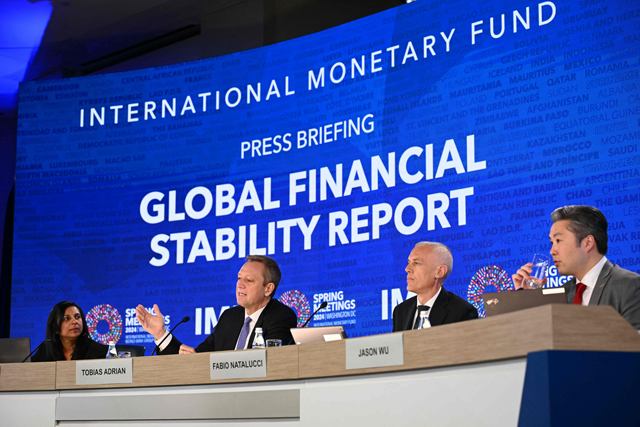You are here
IMF slashes global growth outlook amid Omicron hit
By AFP - Jan 25,2022 - Last updated at Jan 25,2022
WASHINGTON — The Omicron variant of COVID-19 is creating an obstacle course for the global economy, which will slow growth this year, notably in the world's two largest economies, the IMF said Tuesday.
The Washington-based crisis lender cut its world GDP forecast for 2022 to 4.4 percent, half a point lower than the October estimate, due to the "impediments" caused by the latest outbreak, though those are expected to begin to fade in the second quarter of the year.
"The global economy enters 2022 in a weaker position than previously expected," the IMF said in the quarterly update to its World Economic Outlook, adding that "the emergence of the Omicron variant in late November threatens to set back this tentative path to recovery".
Meanwhile, "Rising energy prices and supply disruptions have resulted in higher and more broad-based inflation than anticipated," which is projected to last longer than previously expected.
After the solid recovery last year when the global economy grew an estimated 5.9 per cent, the IMF cut projections for nearly every country, with India a notable exception, but it was the downgrades to the United States and China that had the biggest impact.
“These impediments are expected to weigh on growth in the first quarter of 2022,” the report said.
“The negative impact is expected to fade starting in the second quarter, assuming that the global surge in Omicron infections abates and the virus does not mutate into new variants that require further mobility restrictions.”
The International Monetary Fund (IMF) once again stressed that controlling the pandemic is critical to the economic outlook and urged widespread vaccinations in developing nations, which have fallen short even as advanced economies have moved to deploying booster shots among their already highly-vaccinated populations.
“Without this worldwide effort, the virus will be more likely to mutate further and extend the pandemic’s global grip,” the fund said.
US, China slowdown
The biggest drag on the global outlook is the sharp slowing in the United States and China, including factors beyond the impact of the virus.
With US President Joe Biden’s massive social spending plan stalled in Congress, the IMF subtracted the expected growth impact the program would have had on the economy.
Together with the supply chain snarls that have beset American businesses and manufacturing, these factors slashed 1.2 percentage points off GDP, which is now expected to expand 4 per cent this year, the IMF said.
While that is a historically high rate for the world’s largest economy, it is far slower than the 5.6 per cent expansion in 2021.
Meanwhile, renewed lockdowns in China have contributed to slow private consumption, and struggles in the country’s real estate sector cut 0.8 points off expected growth, now projected at 4.8 per cent, the report said.
“As the new Omicron COVID-19 variant spreads, countries have reimposed mobility restrictions. Rising energy prices and supply disruptions have resulted in higher and more broad-based inflation than anticipated, notably in the United States,” the IMF said.
“In China, pandemic-induced disruptions related to the zero-tolerance COVID-19 policy and protracted financial stress among property developers have induced a 0.8 percentage point downgrade.”
Other major economies suffered sharp downgrades amid the ongoing pandemic disruptions, including a 0.8-point cut for Germany, and 1.2-point deductions for Brazil and Mexico.
India, however, saw a 0.5-point upgrade to nine percent, Japan saw a more modest improvement for growth of 3.3 percent, the IMF said.
The outlook for 2023 is somewhat improved, “however not enough to make up ground lost due to the downgrade to 2022. Cumulative global growth over 2022 and 2023 is projected to be 0.3 percentage point lower than previously forecast”.
Inflation flares, rates rise
A key challenge facing the global economy is the surge in prices.
The phenomenon is expected to bring more aggressive action by key central banks like the US Federal Reserve (Fed), whose actions will raise borrowing costs worldwide, hindering recovery efforts, particularly in indebted developing nations.
“Elevated inflation is expected to persist for longer than envisioned in the October WEO, with ongoing supply chain disruptions and high energy prices continuing in 2022,” the IMF said.
If the “the pandemic eases its grip” and energy price increases moderate, “inflation should gradually decrease as supply-demand imbalances wane in 2022 and monetary policy in major economies responds”.
The WEO baseline assumes the Fed will hike the benchmark interest rate three times this year and three in 2023.
Inflation is expected to average 3.9 per cent in advanced economies and 5.9 per cent in emerging market and developing economies in 2022, before subsiding in 2023.
Related Articles
WASHINGTON — Surging inflation and severe slowdowns in the United States and China prompted the International Monetary Fund (IMF) to downgra
WASHINGTON — The International Monetary Fund (IMF) has raised its outlook for the global economy this year, while maintaining a gloomy forec
WASHINGTON — The International Monetary Fund (IMF) has slightly upgraded its outlook for global growth this year on the back of resilient se














